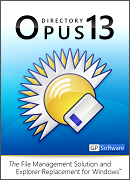Introduction
 Welcome to Directory Opus, your Windows file manager!
Welcome to Directory Opus, your Windows file manager!
Here's what Opus offers:
- Ease of Use: Opus functions similarly to Explorer by default. If you've used Explorer, you'll know how to use Opus.
- Configurability: You can customize almost every part of Opus, from toolbar buttons to the background color of compressed files. Yet, no configuration is required, as the default settings are comprehensive and provide a familiar, easy-to-use environment right out of the box.
- Efficiency: With multi-threading, Opus ensures smooth operations without unnecessary waits.
- Compatibility: Opus integrates seamlessly with your system, appearing just like Explorer. Most software compatible with Explorer works well with Opus.
Though Opus has evolved a lot since its roots on the Amiga in 1989, don't be overwhelmed. Think of it as a versatile tool to make tasks easier. If you spend a lot of time managing files, Opus streamlines these tasks, making you more productive.
As you start to explore Opus here are a few tips to help you get around:
- All the toolbar buttons and menu commands have popup tooltips that describe what they do. If you ever want to know what a command is for, just hover over it with the mouse for a couple of seconds.
- Many dialogs (including the main Preferences dialog) have filter fields that let you search for options matching your keywords.
- Press F1 from anywhere to get to the help. Remember to look at the table of contents on the left for other related topics.
- If you have time, have a quick read through the topics in the Basic Concepts section of this help file. Opus supports the same basic file management concepts as Explorer but this section describes some of the extra functionality that can really help you get the most out of Opus.
- The Opus Resource Centre is a wealth of hints, tips, FAQs, tutorials and knowledgeable Opus users.
Thanks for using Directory Opus! We hope you enjoy using it as much as we enjoy writing it!